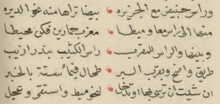Maydh
[2] The city of Maydh was home to Sheikh Isaaq ibn Ahmed Al Hashimi (Sheekh Isaxaaq), who moved to Somaliland from the Arabian Peninsula in the 12th or 13th century CE.
He is considered to be the founding father of the large Somali Isaaq clan family that predominantly inhabits Somaliland, as well as parts of Djibouti and Ethiopia.
[5] Somaliland in general is home to numerous such archaeological sites, with similar edifices found at Haylaan, Qa’ableh, Qombo'ul, Gelweita and El Ayo.
[7][8] Francisco Álvares visited the city who provided a description below of his experience:We met at a place called Meti, which is well sited; it might be of the size of fifty or sixty hearths; it has two mosques, and they are not good ones, but they have many large burial grounds.
And that they had found where they used to make fire and hollows and places where they sought for water to drink, and because of the great mountains they were in hiding; and it was impossible to find them.
[9]Portuguese navigator Duarte Barbosa described the Somali coast and noted Met (Maydh) as a town with an abundance of meat but little trade.
[12] Murray in his book The Journal of the Royal Geographical Society notes that many men from the western Isaaq clans would travel to Maydh to spend the last years of their lives in hopes of being buried near Sheikh Ishaaq.
Attachment to the memory of their forefather Isaakh yet induces many aged men of the western tribes to pass the close of their lives at Meyet, in order that their tombs may be found near that of their chief, and this will account for the unusual size of this cemetery.

